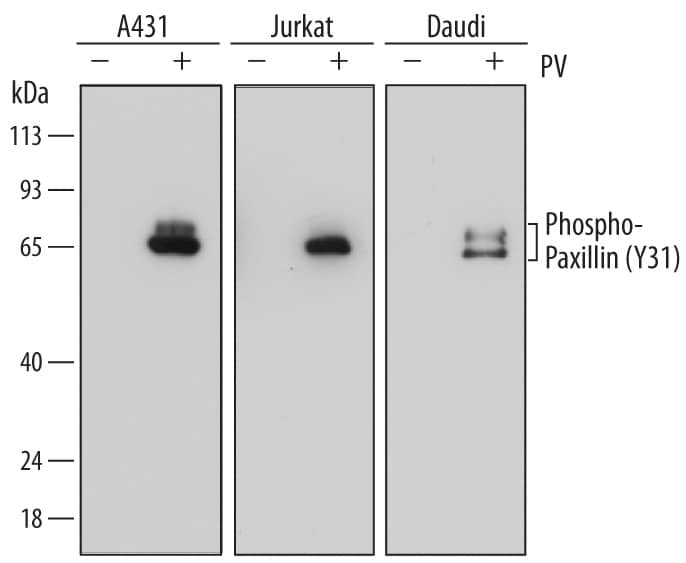Human Phospho-Paxillin (Y31) Antibody
R&D Systems, part of Bio-Techne | Catalog # MAB61641

Key Product Details
Validated by
Biological Validation
Species Reactivity
Human
Applications
Immunocytochemistry, Western Blot
Label
Unconjugated
Antibody Source
Monoclonal Mouse IgG2A Clone # 698239
Product Specifications
Immunogen
Phosphopeptide containing the human Paxillin Y31 site
Specificity
Detects Phospho-Paxillin (Y31) in direct ELISAs and Western blots.
Clonality
Monoclonal
Host
Mouse
Isotype
IgG2A
Scientific Data Images for Human Phospho-Paxillin (Y31) Antibody
Detection of Human Phospho-Paxillin (Y31) by Western Blot.
Western blot shows lysates of A431 human epithelial carcinoma cell line, Jurkat human acute T cell leukemia cell line, and Daudi human Burkitt's lymphoma cell line untreated (-) or treated (+) with 1 mM Pervanadate (PV) for 30 minutes. PVDF membrane was probed with 0.1 µg/mL of Mouse Anti-Human Phospho-Paxillin (Y31) Antigen Affinity-purified Monoclonal Antibody (Catalog # MAB61641) followed by HRP-conjugated Anti-Mouse IgG Secondary Antibody (Catalog # HAF007). Specific bands were detected for Phospho-Paxillin (Y31) at approximately 65 to 68 kDa (as indicated). This experiment was conducted under reducing conditions and using Immunoblot Buffer Group 1.Paxillin in HUVEC Human Cells.
Paxillin phosphorylated at Y31 was detected in immersion fixed HUVEC human umbilical vein endothelial cells using Mouse Anti-Human Phospho-Paxillin (Y31) Antigen Affinity-purified Monoclonal Antibody (Catalog # MAB61641) at 10 µg/mL for 3 hours at room temperature. Cells were stained using the NorthernLights™ 557-conjugated Anti-Mouse IgG Secondary Antibody (red, upper panel; Catalog # NL007) and counterstained with DAPI (blue, lower panel). Specific staining was localized to nuclei and focal adhesions. View our protocol for Fluorescent ICC Staining of Cells on Coverslips.Applications for Human Phospho-Paxillin (Y31) Antibody
Application
Recommended Usage
Immunocytochemistry
8-25 µg/mL
Sample: Immersion fixed HUVEC human umbilical vein endothelial cell line
Sample: Immersion fixed HUVEC human umbilical vein endothelial cell line
Western Blot
0.1 µg/mL
Sample: A431 human epithelial carcinoma cell line, Jurkat human acute T cell leukemia cell line, and Daudi human Burkitt's lymphoma cell line treated with Pervanadate (PV)
Sample: A431 human epithelial carcinoma cell line, Jurkat human acute T cell leukemia cell line, and Daudi human Burkitt's lymphoma cell line treated with Pervanadate (PV)
Formulation, Preparation, and Storage
Purification
Protein A or G purified from hybridoma culture supernatant
Reconstitution
Sterile PBS to a final concentration of 0.5 mg/mL. For liquid material, refer to CoA for concentration.
Formulation
Lyophilized from a 0.2 μm filtered solution in PBS with Trehalose. *Small pack size (SP) is supplied either lyophilized or as a 0.2 µm filtered solution in PBS.
Shipping
Lyophilized product is shipped at ambient temperature. Liquid small pack size (-SP) is shipped with polar packs. Upon receipt, store immediately at the temperature recommended below.
Stability & Storage
Use a manual defrost freezer and avoid repeated freeze-thaw cycles.
- 12 months from date of receipt, -20 to -70 °C as supplied.
- 1 month, 2 to 8 °C under sterile conditions after reconstitution.
- 6 months, -20 to -70 °C under sterile conditions after reconstitution.
Background: Paxillin
Additional Paxillin Products
Product Documents for Human Phospho-Paxillin (Y31) Antibody
Product Specific Notices for Human Phospho-Paxillin (Y31) Antibody
For research use only
